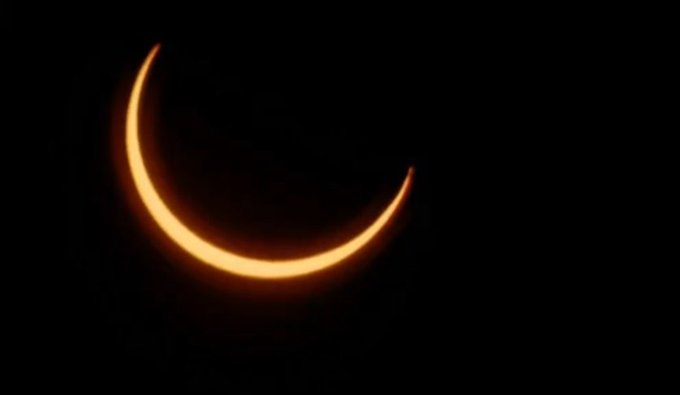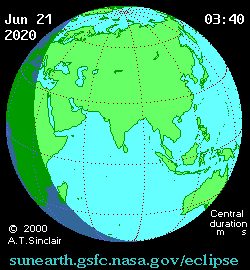 |
| Alamata, Ethopia #SolarEclipse2020 Credit: https://twitter.com/Landoforigins/status/1274567772471730176/photo/1 |
An annular solar eclipse occurred on, June 21, 2020. A solar eclipse occurs when the Moon crosses the Earth and the Sun; thereby, partly or totally covering the image of the Sun for an observer on Earth. An annular solar eclipse occurs when the Moon's apparent diameter is smaller than the Sun's, blocking most of the Sun's light and making the Sun look like an annulus (ring). An annular eclipse looks like a particle eclipse over a region of the Earth thousands of kilometres wide.
The eclipse went through central and northeast Africa, Saudi Arabia, Pakistan, northern India, and southern China including Taiwan. But rather than totally blocking the sun, it would leave a "ring of fire" from the sun at the maximum point.
There was an event live stream for people who don't have the eclipse in their country. The eclipse started at 5:45 pm (NZDT).
The eclipse was seen in the northeast of the Republic of Congo at 5:56 am (local time), 4:56 am (GMT), just a few minutes after sunrise.
That was the point of maximum duration, with the blackout lasting 1 minute and 22 seconds.
Going more east across Asia and Africa will reach it's "maximum eclipse", which a perfect solar halo around the Moon, over Uttarakhand, India near the Sino-Indian border at 12:10 local time (6:40 GMT). The alignment of the Earth, Moon and Sun was visible only for 38 seconds.
For Oman and India, it was the second annular eclipse 6 months after the 26 December 2019 eclipse.
Florent Delefie, an astronomer and the Paris Observatory told AFP, "The annular eclipse is visible from about two percent of Earth surface"
Florent Delefie, an astronomer and the Paris Observatory told AFP, "The annular eclipse is visible from about two percent of Earth surface"
He added, "It's a bit like switching from a 500-watt to a 30-watt light bulb. It's a cold light, and you don't see as well."
 |
| Animation of the solar eclipse Attribution: NASA / Public Domain Credit: https://commons.wikimedia.org/wiki/File:SE2020Jun21A.gif |
Astrophysicist Fred Espenak, an expert on eclipse prediction, commented on the NASA Eclipse website. "Good weather is the key to successful eclipse viewing. Better to see a shorter eclipse from a clear sky than a longer eclipse under clouds."
A solar eclipse always occurs about two weeks before or after a lunar eclipse, when the Moon moves into Earth's shadow. Lunar eclipses are visible from about half of Earth's surface.
There's a second solar eclipse on December 14, 2020, over South America. Because the Moon will be closer to Earth, it will block on the Sun's light entirely.
Sources: